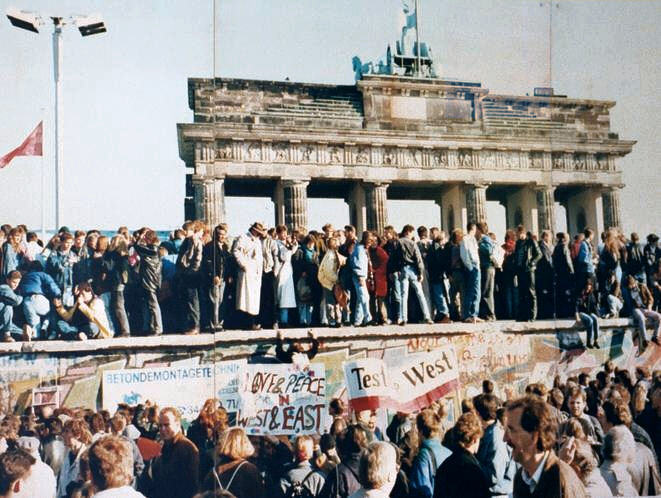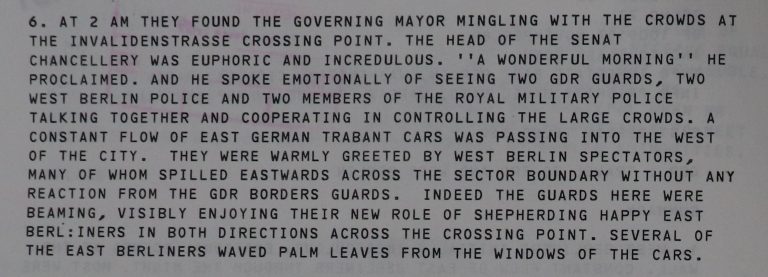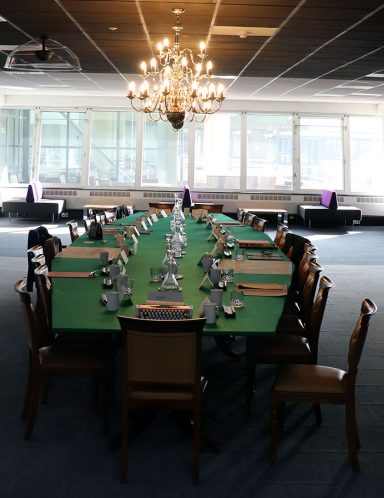General Secretary Gorbachev, if you seek peace, if you seek prosperity for the Soviet Union and Eastern Europe, if you seek liberalisation: Come here to this gate! Mr. Gorbachev, open this gate! Mr. Gorbachev, tear down this wall!
I must admit that when, at the time and at the age of 26, I saw a clip of this extract from President Ronald Reagan’s speech to the people of West Berlin on 12 June 1987, I thought ‘there’s absolutely no chance of that! That wall will never come down!’. How wrong I was! At least I can comfort myself that I was not alone in not seeing this coming!

West and East Germans at the Brandenburg Gate, 1989 (Creative Commons)
Potent symbol of the Cold War
In 1961 Soviet leader Nikita Khrushchev had ordered the construction of the Berlin Wall, about a hundred miles long, to prevent skilled workers from leaving East Berlin to live in the West. The wall surrounded West Berlin, and its fortifications included electrified fences and guard posts. Figures vary, but over the years, hundreds of people were killed trying to cross the wall.
The Berlin Wall became a potent symbol of the Cold War divisions between West and East, between capitalism and communism, democracy and authoritarianism. It represented the ‘checkmate’ stand-off between the world’s superpowers. There was a strong sense of permanence about this barrier. But in reality metaphorical cracks had started to appear in the wall in the 1980s.
Cracks start to appear
Communism in Eastern Europe was facing a deepening crisis. It was failing to deliver improved living standards. In Poland from 1980 onwards, the Solidarity movement, an independent trade union, organised strikes which weakened the authority of the communist government. Mikhail Gorbachev’s appointment as General Secretary of the Communist Party in 1985 heralded a new era; reformists in Eastern Europe were encouraged by his policies of perestroika (restructuring) and glasnost (open and frank discussion).
Changes gathered momentum in the autumn of 1989. In August, Tadeusz Mazowiecki became Poland’s Prime Minister – the first non-Communist leader in the Soviet bloc since the 1940s. In September, Hungary opened its borders with the West, allowing thousands of East Germans to escape to West Germany. A visit by Gorbachev to East Germany on 6 October had the effect of boosting the increasing tide of protest against the Communist regime in the GDR.
An historical accident
When the wall was breached, on 9 November 1989, it came about as a result of an accident. The East German leadership had produced a new set of regulations, which would make it easier for East Germans to travel, using visas. The intention was to announce the changes on the evening of 9 November, and introduce the new system the next morning. However, when Günter Schabowski, an East German Communist Party official, was asked at a live press conference when the new rules would come into effect, he blundered and said ‘immediately’. Shortly after this surprise development, hundreds of East Berliners started to turn up at the sector crossing points – the crowds swelled into thousands. The GDR border guards were normally under orders to stop anyone crossing. They had no fresh instructions, and decided spontaneously to open the barriers, enabling thousands to pour through.
Where were you?
Where were you when the Berlin Wall was first breached? Chances are that, if you were around on 9 November 1989, you were watching the historic scenes on the evening news on television of joyful crowds of East Germans pouring through the newly opened checkpoints, swarming around the wall, drinking and celebrating. The people had taken control.
The images of people starting to hammer away at the wall with pickaxes were particularly powerful. It brought out emotional reactions for many people. One of those glued to their television set that night was Prime Minister Margaret Thatcher. In a letter, Charles Powell gave an account of a telephone call that the Prime Minister had made to the German Chancellor Helmut Kohl on 10 November: ‘The Prime Minister said that she had been watching the scenes in Berlin on television. Both last night and this morning. They were some of the most historic which she had ever seen’[ref]PREM 19/2696[/ref].
Extraordinary scenes captured in our documents
Historical events involving a mass outbreak of euphoria are a rare commodity. Telegrams in Foreign and Commonwealth files held by The National Archives, sent on the morning of 10 November, capture the initial incredulity and sheer joy experienced by many participants in this momentous event. Nigel Broomfield, HM Ambassador for East Berlin, wrote to Foreign Secretary Douglas Hurd: ‘The GDR border guards were forced to give way and thousands drove, walked and ran over the border, some still in their night clothes, hardly believing their eyes, to be reunited with friends or relatives, but mostly to see what the West was like’[ref]FCO 33/10153, WRE 014/2[/ref].
![Telegram from Nigel Broomfield, HM Ambassador East Berlin, to Douglas Hurd, Foreign Secretary, 7.40 am, 10 November 1989. This extract reads: 'My Tel [Telegram] no 370: GDR Internal Developments: Travel to the FRG and West Berlin. Summary: 1. An historic night. Free travel between East and West Berlin. Extraordinary scenes of emotion. The real test starts today. Next steps must be free elections.' Catalogue reference: FCO 33/10153](https://cdn.nationalarchives.gov.uk/blog/wp-content/uploads/2019/11/06120610/Broomfield-to-FCO-768x171.jpg)
Telegram from Nigel Broomfield, HM Ambassador East Berlin, to Douglas Hurd, Foreign Secretary, 07.40, 10 November 1989. Catalogue reference: FCO 33/10153
In another telegram to Hurd, Major-General Robert Corbett wrote that ‘the [former GDR border] guards here were beaming, visibly enjoying their new role of shepherding happy East Berliners in both directions across the crossing point. Several of the East Berliners waved palm leaves from the windows of their cars’. He continued: ‘The Brandenburg Gate at 3 am presented an amazing scene…eventually as many as 600 young people were on top of the wall, bathed in television lights, mostly quietly enjoying the unique occasion, and occasionally shouting “the wall must go”. Some were chipping at the wall with hammer and chisel and distributing pieces to the crowd’. Corbett also stated that ‘a common goal for many East Berliners was the “Ku’damm”, West Berlin’s main shopping avenue. At 4.30 am, it was lined with East German registered Trabants’ (iconic cars ‘of the people’)[ref]FCO 33/10154, WRE 014/2[/ref]. Such telegrams conjure up a vivid series of pictures, described with eloquence.

Telegram from Major-General Robert Corbett to Douglas Hurd, Foreign Secretary, 10 November 1989, 09.15. Catalogue reference: FCO 33/10154
Of course, the euphoria was not universally shared. In a recent interview given to the BBC, Egon Krenz, East Germany’s last Communist leader, said that, while he understood it was a celebration of people power, the fall of the Berlin Wall ‘was the worst night of my life’. But for the majority of participants, the words of William Wordsworth seem appropriate: ‘bliss was it in that dawn to be alive’. The political complications of the reunification of Germany were yet to come. This was a glorious moment for humanity and freedom.
We are marking the 30th anniversary of the fall of the Berlin Wall with our recreated Cabinet table, which you can see on the first floor here at The National Archives (until 23 November) set out for a Cabinet meeting at that time, with facsimile documents showing Prime Minister Margaret Thatcher’s reactions to this historic event, and the history surrounding it.

The recreated Cabinet table at The National Archives
Further Reading
‘Britain and the Revolutions in Eastern Europe, 1989: Documents on British Policy Overseas’, Series III, Volume XII, ed. Richard Smith (Routledge, 2019)
Great stuff. Reviewing these records and selecting them for release at TNA must have been a satisfying and rewarding experience for everyone involved.
I think it was Nikita Khrushchev who gave permission (rather than ordered) for the wall to be built, of course there outer and inner walls, but it was Ulbricht’s wish to have the wall. It is well-known that Margaret Thatcher was frightened by the idea of a united Germany and following the fall of the wall many people in the GDR no longer had jobs (having been employed by the GDR state) and their standard of living has not been equalised since then, for example the rail fares had to be looked at as they were much lower in the GDR as opposed to those in the West. Of course whilst Hungary allowed citizens of the GDR to escape, it was also abetted by Austria to allow them to go to the Federal Republic of Germany. We should not forget that about 140 citizens of the GDR died trying to escape through the wall.